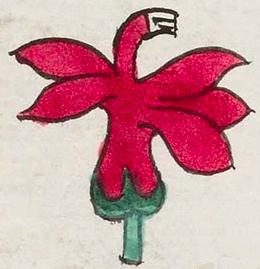Acaxochic (Mdz32r)
This simplex glyph is a flower that is a type of lobelia, ācaxōchitl), standing for the full name of the town, Acaxochic, minus the -c locative suffix, which is not represented visually. The flower is a bright red, somewhat reminiscent of the cardinal flower or the flower of the canna lily, but it is a tuberous flower in the lobelia family. It has a green stem and a small yellow tip above the red. The word ācaxochitl is a compound of sorts with two parts, ācatl), or reed, and xōchitl), flower.
Stephanie Wood
According to Frances Karttunen, the -c suffix is a short form of the locative suffix -co.
Stephanie Wood
acaxochic. puo
Acaxochic, pueblo
Stephanie Wood
c. 1541, or by 1553 at the latest
Stephanie Wood
flowers, lobelias, tuberous plants, reeds, flores, nombres de lugares

ācaxōchi(tl), tuberous lobelia, https://nahuatl.wired-humanities.org/content/acaxochitl
āca(tl), reed, https://nahuatl.wired-humanities.org/content/acatl
xōchi(tl), flower, https://nahuatl.wired-humanities.org/content/xochitl
-c (locative suffix), https://nahuatl.wired-humanities.org/content/c
"Acaxochitl Place" [Frances Karttunen, "Critique of glyph catalogue in Berdan and Anawalt edition of Codex Mendoza," unpublished manuscript, used here with her permission.]
"On the Acaxochitl" (Berdan & Anawalt, v. 1, p. 168)
Codex Mendoza, folio 32 recto, https://digital.bodleian.ox.ac.uk/objects/2fea788e-2aa2-4f08-b6d9-648c00..., image 74 of 188.
The Bodleian Libraries, University of Oxford, hold the original manuscript, the MS. Arch. Selden. A. 1. This image is published here under the UK Creative Commons, “Attribution-NonCommercial-ShareAlike 3.0 License” (CC-BY-NC-SA 3.0).



